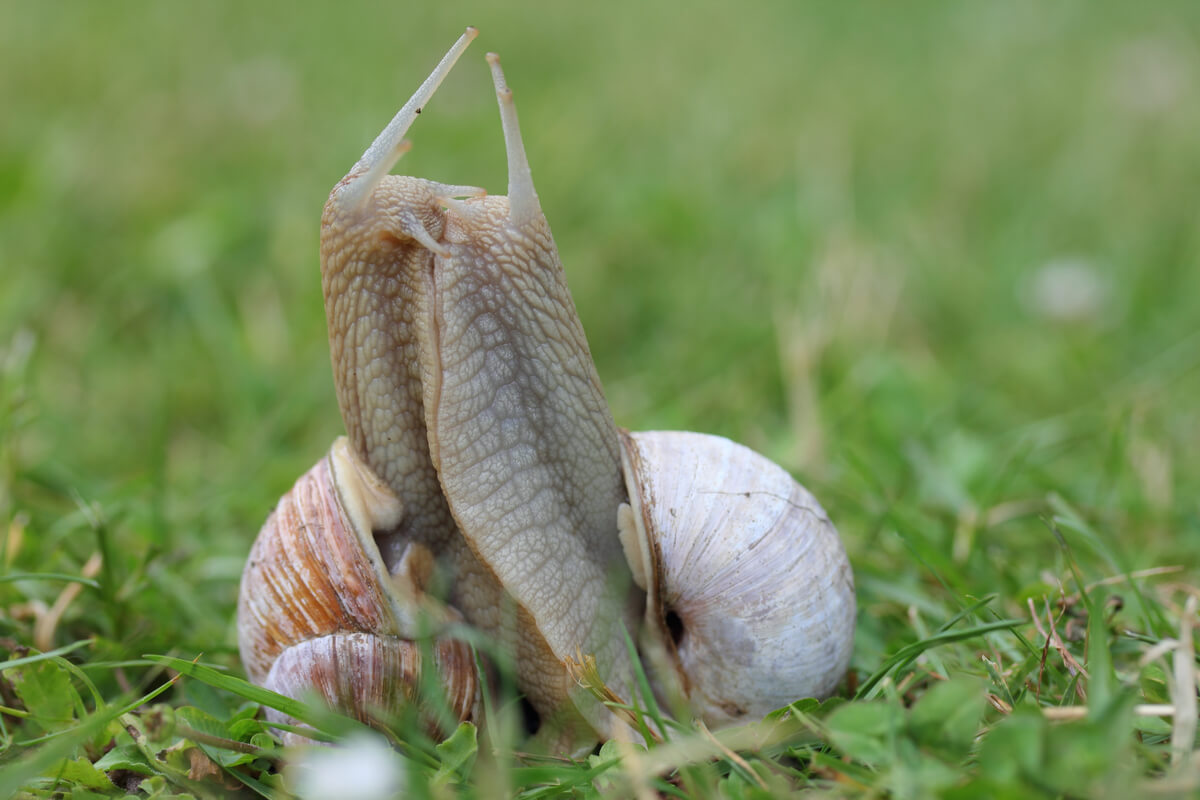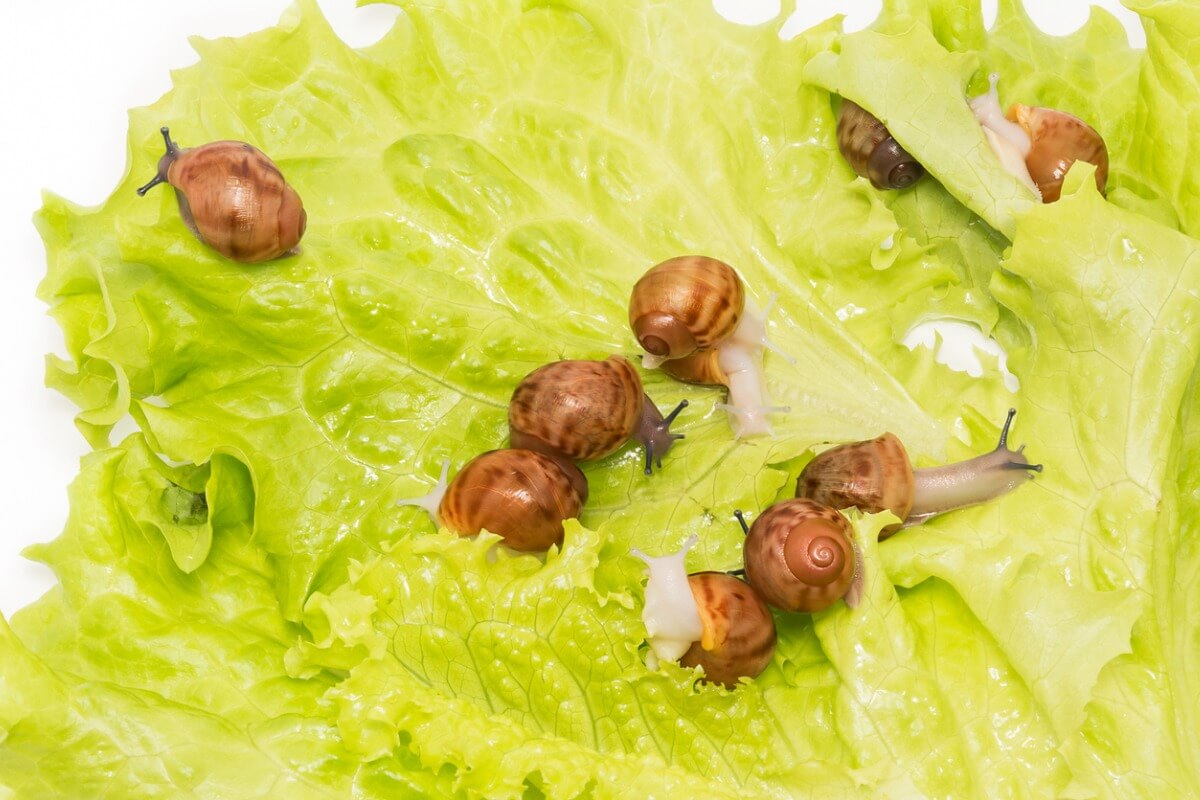Do You Know How Snails Are Born?


Written and verified by the biologist Cesar Paul Gonzalez Gonzalez
Snails are one of the best-known invertebrates because all their specimens have a protective device known as a shell. This protection protects their fragile body, which is usually very flaccid and similar to that of a slug. Although it’s such a common animal, many people aren’t aware of the life cycle of a snail. So, today we’ll look at how snails are born and how they reproduce.
In general, the term “snail” refers to mollusks of the Gastropoda class that have a spiral shell with different shapes. This group has terrestrial, marine, and freshwater representatives, and so the diversity of their shells is incredible. Read on to learn more about how snails reproduce and are born.
What do snails look like?
The physical appearance of this invertebrate closely resembles that of a slug, but with a shell on top. The texture of its skin is usually similar to that of a jelly, as it’s flaccid and secretes a slippery substance that allows it to move (mucus). These organisms don’t have feet, so they move by undulating their skin and reducing friction by producing mucus.
As for the structure of its shell, it’s made of calcium carbonate. In addition, its shape has a large hollow on the inside that’s usually sufficient for the whole organism to be able to retract inside. Also, in this protective device the snail keeps all its important organs, such as the liver, lungs, stomach, kidney and heart.
As the snail grows, its shell also becomes wider, so this is usually an indirect way to estimate the age of a specimen. Likewise, if this protection is damaged or broken, it can be repaired (as long as it hasn’t affected any of the animal’s vital organs).
The snail’s flaccid body exhibits sensitive structures such as eyes, which are located at the tip of the antennae that come out of its head. In addition, the mouth has a toothed mouth structure – a radula – that works like a chainsaw and allows it to gnaw leaves and even extract calcium from stones.

How do snails reproduce?
An exceptional characteristic of snails is that they’re hermaphrodite specimens, which means that both sexes are present in the same individual. Contrary to what you might think, this doesn’t mean that they can fertilize themselves, as they still need another snail to reproduce.
The mating season of these invertebrates usually overlaps with the wettest times of the year. This is because both the young and the parents can move better when there’s a lot of water around them. Thanks to this, they’re able to carry out their courtship ritual without fear of drying up.
Courtship and copulation
Snail courtship isn’t usually effusive, but it does have its peculiarities. To begin with, both organisms begin to groom each other, rubbing their heads and radulae to incite mating. At the moment they’re reaching climax, both throw a type of calcareous dart at each other that has the function of stimulating their male reproductive organ.
Because they both have both reproductive apparatuses, each snail penetrates the female reproductive orifice of its partner and exchanges spermatophores. As the name implies, this structure is a pouch that contains the sperm to fertilize the individual. The whole process of courtship and copulation can take between 5 and 12 hours in total.
Selecting the father
As in other animals, snails have a selection process to decide who will be the father of their offspring. These invertebrates make their choice after copulation by saving the spermatophores of several mates until they’re sure they have found the best suitor. They use the sperm of the desired father and feed on the rest of the spermatophores.
The choice is essential for these organisms, as childbirth is a very energy-consuming process. In this way, they ensure that the wear and tear will be worth it and that their offspring will exhibit the best characteristics of their environment.
How are snails born?
Once the individual has selected the sperm, they’re transported to the oviduct (where they’ll fertilize the eggs). During this same event, the eggs are covered by a calcareous layer that will harden on contact with the air. This means that snails have a type of oviparous reproduction that’s based on the laying of fertile eggs, which carry their offspring inside.
Laying takes place 10 to 30 days after fertilization, so the parents have time to build a small nest to deposit their eggs. When the time comes, the snail releases between 50 and 150 eggs into the environment in a period which can vary between 20 and 40 hours. This process is so strenuous that the snail usually rests in its shell at the end of the laying.
The incubation of the eggs takes 10 to 25 days and the hatching depends on the temperature and humidity in the nest. After hatching, the little hatchlings stay in the nest feeding on their yolk and shell in order to have the nutrients necessary to survive. After 10 days, they leave their nest to begin their independence.
Are snails born with their shell?
At birth, the body of the snails already has a thin, transparent shell. However, in order to harden this protection, they need to consume calcium, which they get by feeding on the shells they have just broken. This doesn’t only allow them to harden their shells, but also to increase their size (which is necessary for them to survive in their environment).
Although it sounds strange, the shell isn’t just a structure that you can take off or put on a snail, but, rather, it’s a fundamental part of its body. This is because its skin, in a section called the mantle, secretes the shell that will harden over time. In this way, as long as calcium is abundant, the gastropod can produce or repair its shell.
As you can see, snail shells maintain a helical shape caused by the internal arrangement of their organs. In the end, the mantle is a folding of skin that covers and protects the interior, so, when the shell substance secretes, this pattern appears.

The life cycle of snails isn’t as easy as it seems, because, even though many follow what we’ve already described, there are also many exceptions. Even so, the magnificent ability they have to secrete their own shell makes them truly stand out from other organisms. Every living thing has its own particular way of amazing us, and snails are certainly one of the most outstanding!
Snails are one of the best-known invertebrates because all their specimens have a protective device known as a shell. This protection protects their fragile body, which is usually very flaccid and similar to that of a slug. Although it’s such a common animal, many people aren’t aware of the life cycle of a snail. So, today we’ll look at how snails are born and how they reproduce.
In general, the term “snail” refers to mollusks of the Gastropoda class that have a spiral shell with different shapes. This group has terrestrial, marine, and freshwater representatives, and so the diversity of their shells is incredible. Read on to learn more about how snails reproduce and are born.
What do snails look like?
The physical appearance of this invertebrate closely resembles that of a slug, but with a shell on top. The texture of its skin is usually similar to that of a jelly, as it’s flaccid and secretes a slippery substance that allows it to move (mucus). These organisms don’t have feet, so they move by undulating their skin and reducing friction by producing mucus.
As for the structure of its shell, it’s made of calcium carbonate. In addition, its shape has a large hollow on the inside that’s usually sufficient for the whole organism to be able to retract inside. Also, in this protective device the snail keeps all its important organs, such as the liver, lungs, stomach, kidney and heart.
As the snail grows, its shell also becomes wider, so this is usually an indirect way to estimate the age of a specimen. Likewise, if this protection is damaged or broken, it can be repaired (as long as it hasn’t affected any of the animal’s vital organs).
The snail’s flaccid body exhibits sensitive structures such as eyes, which are located at the tip of the antennae that come out of its head. In addition, the mouth has a toothed mouth structure – a radula – that works like a chainsaw and allows it to gnaw leaves and even extract calcium from stones.

How do snails reproduce?
An exceptional characteristic of snails is that they’re hermaphrodite specimens, which means that both sexes are present in the same individual. Contrary to what you might think, this doesn’t mean that they can fertilize themselves, as they still need another snail to reproduce.
The mating season of these invertebrates usually overlaps with the wettest times of the year. This is because both the young and the parents can move better when there’s a lot of water around them. Thanks to this, they’re able to carry out their courtship ritual without fear of drying up.
Courtship and copulation
Snail courtship isn’t usually effusive, but it does have its peculiarities. To begin with, both organisms begin to groom each other, rubbing their heads and radulae to incite mating. At the moment they’re reaching climax, both throw a type of calcareous dart at each other that has the function of stimulating their male reproductive organ.
Because they both have both reproductive apparatuses, each snail penetrates the female reproductive orifice of its partner and exchanges spermatophores. As the name implies, this structure is a pouch that contains the sperm to fertilize the individual. The whole process of courtship and copulation can take between 5 and 12 hours in total.
Selecting the father
As in other animals, snails have a selection process to decide who will be the father of their offspring. These invertebrates make their choice after copulation by saving the spermatophores of several mates until they’re sure they have found the best suitor. They use the sperm of the desired father and feed on the rest of the spermatophores.
The choice is essential for these organisms, as childbirth is a very energy-consuming process. In this way, they ensure that the wear and tear will be worth it and that their offspring will exhibit the best characteristics of their environment.
How are snails born?
Once the individual has selected the sperm, they’re transported to the oviduct (where they’ll fertilize the eggs). During this same event, the eggs are covered by a calcareous layer that will harden on contact with the air. This means that snails have a type of oviparous reproduction that’s based on the laying of fertile eggs, which carry their offspring inside.
Laying takes place 10 to 30 days after fertilization, so the parents have time to build a small nest to deposit their eggs. When the time comes, the snail releases between 50 and 150 eggs into the environment in a period which can vary between 20 and 40 hours. This process is so strenuous that the snail usually rests in its shell at the end of the laying.
The incubation of the eggs takes 10 to 25 days and the hatching depends on the temperature and humidity in the nest. After hatching, the little hatchlings stay in the nest feeding on their yolk and shell in order to have the nutrients necessary to survive. After 10 days, they leave their nest to begin their independence.
Are snails born with their shell?
At birth, the body of the snails already has a thin, transparent shell. However, in order to harden this protection, they need to consume calcium, which they get by feeding on the shells they have just broken. This doesn’t only allow them to harden their shells, but also to increase their size (which is necessary for them to survive in their environment).
Although it sounds strange, the shell isn’t just a structure that you can take off or put on a snail, but, rather, it’s a fundamental part of its body. This is because its skin, in a section called the mantle, secretes the shell that will harden over time. In this way, as long as calcium is abundant, the gastropod can produce or repair its shell.
As you can see, snail shells maintain a helical shape caused by the internal arrangement of their organs. In the end, the mantle is a folding of skin that covers and protects the interior, so, when the shell substance secretes, this pattern appears.

The life cycle of snails isn’t as easy as it seems, because, even though many follow what we’ve already described, there are also many exceptions. Even so, the magnificent ability they have to secrete their own shell makes them truly stand out from other organisms. Every living thing has its own particular way of amazing us, and snails are certainly one of the most outstanding!
All cited sources were thoroughly reviewed by our team to ensure their quality, reliability, currency, and validity. The bibliography of this article was considered reliable and of academic or scientific accuracy.
- Naranjo-García, E. (2014). Biodiversidad de moluscos terrestres en México. Revista mexicana de biodiversidad, 85, 431-440.
- De la Piedra, R. (2005). Biología del caracol (Helix aspersaMuller) y propuesta de instalación de un criadero mixto modificado. Tesina de Médico Veterinario. Lima: Universidad Nacional Mayor de San Marcos.
- Castillejo, J. (1986). Caracoles terrestres de Galicia. Familia Helicidae (Gastropoda: Pulmonata). Universidad de Santiago de Compostela, Lugo.
- Díaz, J. L., Aguirre, J. C., Mejía, G., & Martínez, E. (2007). Reproducción y genética del caracol terrestre “Helix aspersa”. Revista CES Medicina Veterinaria y Zootecnia, 2(2), 78-88.
- Ramírez, R., Borda, V., Romero, P., Ramirez, J., Congrains, C., Chirinos, J., … & Mejía, K. (2012). Biodiversidad y endemismo de los caracoles terrestres Megalobulimus y Systrophia en la Amazonia occidental. Revista peruana de biología, 19(1), 59-74.
This text is provided for informational purposes only and does not replace consultation with a professional. If in doubt, consult your specialist.








